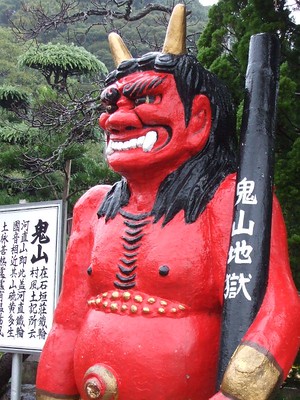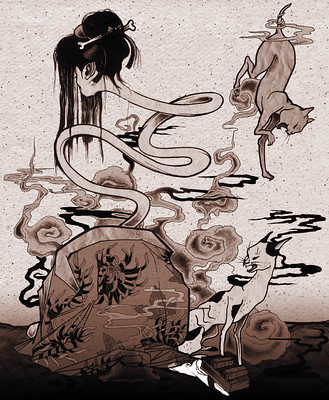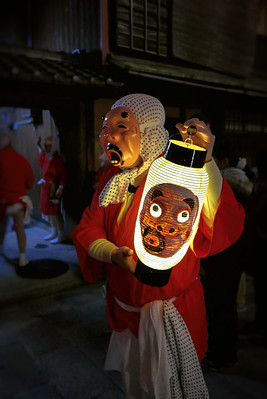In Japanese culture, there are many kinds of mythical creatures that Japanese are familiar with.
These creatures show up in children”s picture books, anime and so on. So the topic of mythical Japanese creatures is not unfamiliar amongst the population.
So, in this guide, we will look at mythical creatures that are very popular and familiar with all the native Japanese: “kappa”(河童), “tengu”(天狗), and “oni”(鬼).
1. Kappa
河童
- An amphibious imaginary animal.
A kappa is about 1 meter tall, has a sharp mouth, and has a dent above its head called “sara”(さら) – which means “a plate” – to store a small amount of water.

The creature is often said to have a child-like physique, and its whole body is green. It has a tortoise shell on its back and a round plate on its head. The “sara”(さら), or plate, is always filled with water, and it is said that if the plate dries up or cracks, the Kappa loses its power.
Despite the fact that the “kappa” is often depicted as a cute and humorous creature, it is said to pull people and other animals into the water, suck their blood, and pull out their intestines from their buttocks. Yikes.
Kappa often appear in proverbs as well, which shows how familiar the “kappa” is in Japanese culture. Let’s look at some of the Japanese proverbs which include “kappa.”
Kappa no kawanagare (河童の川流れ)
Even a kappa, which is considered to be an excellent swimmer, can be swept away by the water and drown – a parable of how even the master of the road sometimes fails.
The equivalent English proverb is “The best horse stumbles,” or more simply, “everyone, masters included, make mistakes.”
Kappa no kangeiko (河童の寒稽古)
kangeiko (寒稽古) means “winter practice”. In this case, they are referring to swimming practice in the cold winter. The Kappa, which live naked in the water, do not mind even if they’re practicing swimming in the cold. This is a parable of the fact that even if it looks painful to others, the person himself doesn’t feel anything.
2. Tengu
天狗
Tengu is a Japanese mythical creature that lives deep in the mountains. It has a red face, a long nose, wings on its back and has supernatural powers and is said to fly freely.

There are a few types of Tengu, from “Ōtengu / Daitengu”(大天狗 ), which means “big Tengu” with a long nose, to “Karasu Tengu ( 烏天狗), or “crow Tengu,” with a beak. Mythical stories about Tengu are told and passed down in various regions, and various mysterious phenomena that occur in the mountains are often believed to be attributed to Tengu.
While there are stories that “Tengu” frighten people, there is also the view that Tengu frightening humans is punishment for violating the realm of the mountain god, and that it is harmless if you know your territory. If we can coexist well, there are many stories that say the Tengu will benefit humans, giving us strength or even teaching humans martial arts.
There are “Tengu jinja”(天狗神社)/ “Tengu shrine” in many places all over japan, as well as “Tengu yama”(天狗山)/ “Tengu mountain”. It shows that folklore is widespread across the country. One of the famous “Tengu yama”(天狗山)/ “Tengu mountain” is in Otaru, where the night view seen from there is as famous as one of the three major night views in Hokkaido.
3. Oni
鬼
The myth of the monster “oni” has been passed down in Japanese history since ancient times.

With a horned head and a mouth full of fangs with raised eyes, the terrifying appearance of the oni wielding an iron club makes people tremble. When an “Oni”(鬼) appears in Japanese cartoons, they have one or two horns on their heads, fine curly hair, fangs in their mouths, sharp claws on their fingers, and they wear loincloths or loincloths made of tiger skin.
On the other hand, “Oni”(鬼)/ demons appear in various aspects of our lives in favorable way. For instance, the Japanese word “kisai” (鬼才)contains the kanji for “Oni”(鬼) and it means “extreme genius”. The children’s game “tag” is called “Oni gokko”(鬼ごっこ) in Japanese. Recently, the demon-themed manga and anime “Kimetsu no Yaiba” (鬼滅の刃) has been a big hit. We have some surnames that contain the word “Oni”(鬼) as well.
There are various legends of “Oni”(鬼) /demons in various places. From “Oni”(鬼) that make people suffer or mislead people, to “Oni”(鬼) that are full of humanity and even gentle.
In some legends, “Oni”(鬼) are believed to exist in hell. Hell demons often act as gatekeepers as subordinates of King Enma, who controls hell.
Surprisingly, “Oni”(鬼) also exist in shrines as gods all throughout Japan. Among them, in Aomori Prefecture, Saitama Prefecture, Oita Prefecture, Fukuoka Prefecture, “Oni”(鬼) are worshipped in these shrines. “Oni”(鬼) can be a hell gatekeeper that everyone dislikes as well as a good god that benefits humans.
One thing that’s for sure is that “Oni”(鬼)/ Demons are very naturally integrated into Japanese daily life through cartoons, folk tales, proverbs, games and even religious beliefs. Depending on the situation, the identities and roles of the “Oni” vary from good to bad.
4. Kitsune
Kitsune means “fox” and they are a well-known mythical creature in Japanese culture.
Japanese people believe that foxes come in two types “holy” and “wild”. The holy foxes act as messengers of the Shinto god called Inari which is the god for rice, fertility, and prosperity. The wild foxes are mischievous and deceptive. The Kitsune are believed to be shapeshifters that can transform into different people and beings. They have been known to shape-shift into women to enchant and deceive people.
5. Hitotsume Kozo
Hitotsume Kozo is also known as the One-Eyed Monk.
It is a type of mythical creature that looks like a monk-in-training with one eye. They are harmless but they can surprise and startle people. In traditional artwork, they are depicted as being humorous and comical.
6. Noppera-bo
This mythical creature can also be known as the “faceless ghost”.
They are harmless but can be frightening. The Noppera-bo will sometimes take the shape of a familiar person so that it can be even scarier. These creatures appear in various traditional folk tales all across Japan.
7. Rokurokubi
These creatures look the same as humans but their necks stretch extremely long. They can pretend to be normal humans but when it becomes night, they will stretch their necks and attack or prey on victims. Compared to other Japanese mythical creatures, the Rokurokubi can be one of the scariest creatures.
8. Bakeneko
This is a shape-shifting mythical creature that is initially in the shape of a cat. Bakeneko can stay hidden while in their cat form, and change suddenly when needed. One of the origins of the Bakeneko is that cats used to lick lamp oils since they were made out of fish oil. The way the cats stretched seemed to look like they were shape-shifting.
9. Amanojaku
This is an evil and demonic mythical creature that has roots farther than Japan’s written language. It can unleash a person’s evil desires and make them act on them. In one folk-tale, called Uriko-hime, the Amanojaku eats a girl and starts to impersonate her.
10. Chochin Obake
Also known as a lantern ghost, the Chochin Obake is a mythical creature that takes the shape of a lantern. The lantern is split with a huge tongue sticking out. There are no specific legends or stories tied to these creatures, but they have been depicted in traditional Japanese artwork.
11. Umi Bozu
Literally meaning, sea monk.
A type of mythical creature that appears in the ocean, the Umi Bozu can show up in the sea in the shape of a shadowy human. They are known to appear in front of sailors when the seas are calm and it can suddenly become turbulent after they appear. Umi Bozu has also been said to shapeshift and cause harm to humans.
Conclusion
Now you know a bit about Japanese mythical creatures.
By knowing these creatures, you will be able to understand Japanese culture better and on a much deeper level.
Which one is your favorite?
Which others would you like to see on this list.
Leave a comment.





